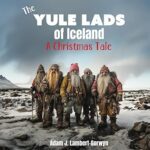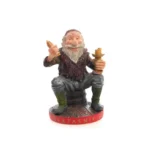Fönnuskafa - Snow Drifter

“Fönnuskafa drifted with the wind, shoveling snow into doorways and paths, locking families in their homes as the storms raged outside.”
Introduction
Fönnuskafa, known as the Snow Drifter, is a cold and calculating figure among the forgotten Yule Lads. His quiet menace lies not in loud pranks or theft but in his subtle ability to trap families inside their homes with towering drifts of snow. As the storm howls outside, Fönnuskafa silently shovels snow against doorways, sealing his victims inside. His name is derived from the Icelandic words fönn (snow) and skafa (scrape or drift), an apt description of his relentless work during the fiercest of winter storms.
Historical Background and Earliest Known Reference
Fönnuskafa’s origins are rooted in Icelandic folklore, symbolizing the dangerous isolation caused by heavy winter snows. In Iceland’s rural past, being snowed in could be deadly, with families cut off from food and heat. Fönnuskafa’s legend serves as a reminder of the harshness of winter, when a simple snowfall could spell disaster. The earliest mentions of Fönnuskafa stem from oral traditions, passed down through generations as a cautionary tale for those who underestimated the power of the season’s elements.
Physical Appearance and Clothing
Fönnuskafa is often depicted as tall and gaunt, with snow permanently dusting his worn clothing. His pale skin and icy blue eyes blend seamlessly with the wintry landscape, making him nearly invisible as he drifts through snowstorms. He wears a heavy, tattered cloak lined with fur, ragged from years of battling the elements. His long, bony fingers are always clutching a snow shovel, tirelessly adding to the heaps of snow that trap families indoors.
Likes, Dislikes, and Habits
Fönnuskafa thrives during the coldest, snowiest nights, where he can go about his work unnoticed. He relishes in the isolation his snow drifts create, knowing that the families trapped inside are at his mercy. Warm winters and clear paths are his greatest frustration, as they rob him of the opportunity to trap his victims. His habits are methodical and relentless—he works slowly but surely, piling snow higher and higher until no one can escape.
Types of Pranks and Mischief
Fönnuskafa’s pranks are not loud or disruptive like some of his brothers. Instead, they are slow, quiet, and insidious. He waits for the dead of night, when the wind howls, and the snow falls thick, using the storm to cover his actions. By morning, families awaken to find their doors buried under mountains of snow, their paths impassable. His pranks are not just inconvenient—they can be life-threatening, especially in the old days when a snowed-in home could run out of food or firewood in mere days.
Relationship with Humans and Other Yule Lads
Fönnuskafa has a distant relationship with humans, as he prefers to act in isolation. His mischief causes more worry than outright harm, but his actions have serious consequences for those caught in his snowdrifts. Among his brothers, Fönnuskafa is known for his quiet efficiency, and he often works in tandem with Svitakrákur, who shares his appreciation for the cold, isolating power of winter. Together, they represent the darker, more dangerous aspects of the season.
Modern Depictions and Popularity
In modern Icelandic folklore, Fönnuskafa has become a symbol of winter’s isolating power. He appears in stories and illustrations as a quiet but ever-present threat during the Christmas season. While his character is less well-known than the modern, mischievous Yule Lads, he still holds a place in Icelandic holiday lore, especially in more remote areas where the dangers of being snowed in remain real.
Fun Facts and Trivia
- Fönnuskafa’s name means “Snow Drifter,” referring to his ability to pile snow high enough to trap families inside their homes.
- He is one of the quieter Yule Lads, preferring to work in silence while the storm rages outside.
- His mischief is subtle but dangerous—being snowed in by Fönnuskafa could mean serious trouble for families, especially in the old days when supplies were limited.
Astrological Sign: Capricorn
Fönnuskafa’s disciplined, patient approach to his work aligns well with the traits of Capricorn. Capricorns are known for their persistence and resilience, qualities that Fönnuskafa embodies as he quietly works to isolate families in their homes during the harshest winter storms. His focus on practical, methodical mischief reflects Capricorn’s strong sense of determination.
Quotes and Cultural Significance
Fönnuskafa’s legend speaks to the dangers of isolation during winter, when even a simple snowstorm could cut off entire families from the outside world. His quiet, relentless work is a reminder of the power of nature, and the importance of being prepared for whatever the season might bring.
Voices of Tradition
“Fönnuskafa rak með snjónum, þögul skref hans ósýnileg, en verk hans þekkt af snjósköflunum sem hann skildi eftir sig.“




